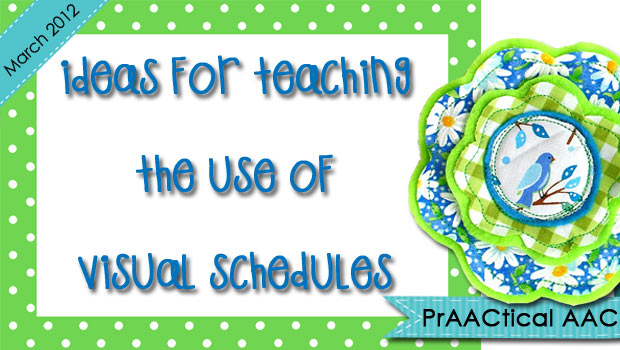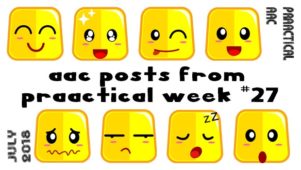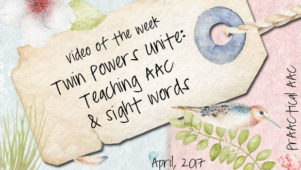Ideas for Teaching the Use of Visual Schedules

/activitystrip2%20aug%20resources.jpg) There’s nothing more depressing to us than walking into a classroom in the spring and seeing pristine visual schedules. Why? Because it probably means that the students aren’t really using them. We cheer when we see schedules that are rumpled and dog-eared, not shiny. Show me a battered and tattered visual schedule, and I’ll show you one that gets used every day. Sadly, that’s not always the case.
There’s nothing more depressing to us than walking into a classroom in the spring and seeing pristine visual schedules. Why? Because it probably means that the students aren’t really using them. We cheer when we see schedules that are rumpled and dog-eared, not shiny. Show me a battered and tattered visual schedule, and I’ll show you one that gets used every day. Sadly, that’s not always the case.
–
The bridge between having a visual schedule and consistently using it is one that many learners don’t seem to cross. Here are some of our ideas for helping your AAC learners to the other side.
–
1. Have a plan to teach the schedule. If you are working one-on-one with a learner, you can easily implement the schedule and get them using it with most-to-least prompting. If you’re working with a group or a classroom, consider staggered implementation. Teaching 12 beginners all at the same time may not be the way to go. Instead, plan to teach 1-2 students per adult at a time. Once those kids get the hang of it and require less guidance, start in with the next pair. That can often be more manageable than trying to teach everyone to use their schedules at the same time.
–
2. Depending on the individual needs of the learners, here are some other things that can help in teaching them to become independent in using visual schedules.
- If the learner has difficulties processing language, keep your verbal instructions to a minimum. Avoid extraneous comments and use only the language most relevant to the task at hand. Pare down long utterances like these: “Let’s get ready to go outside. But first what do we have to do? Check our planner! Let’s go check the schedule and see what’s next.” For someone with limited receptive language skills, this is a better option: “Check the planner.”
- Stand behind him/her when prompting
- Use as little physical support as possible. In the beginning, Jonah needed to be led by the hand to his schedule but within a few days we could walk beside him to guide him to the schedule board. He still needed hand over hand assistance for awhile, but we were able to back off and give less physical support within two weeks.
–
3. Skillful fading of prompts makes a big difference. Pull back your level of assistance as soon as you see signs of independence but don’t go from 60 down to zero in one fell swoop. Gradual reduction of prompts may get your learner to independence faster. There are lots of great sites for information on fading prompts, such as this module from Systematic Instruction Plans and this blog post from Friends of Quinn.
–
4. Consistency matters. The more consistent we are in teaching and using it, the faster our learners will get to the point in which they no longer need to rely on our prompts and cues.
–
5. Use the schedules to preview and review the events to give increased exposure to the system. In this case, more is better. Before we start the session, we can look at all the things we’re going to do, talking about each one as we go down the list. Then it is back to the top to start with our first activity or step. At the end, we can reverse the process to talk about what we did.
–
6. Consider video modeling. Seeing the visual schedule used correctly may help your learner acquire the skills more quickly.
–
7. Assign someone to be responsible for implementation. “Jenna, I’m going to work with Marielle this morning, so I’ll do her schedule until snack. Can you work with her and do her schedule after that?” “Jenna, I’d like you to do the schedule for Marcos and Martin today, and Nancy, you can do James and Justin. I’ll do Sarah and Sammy.” “Nancy, Marcos needs that activity schedule whenever he does his writing work. Can you be sure to use that with him since you’re going to have him in your group?”
–
8. Hold people accountable for implementation. To be effective, visual schedules have to be implemented consistently. Without that in place, the learner doesn’t have much a chance so we have to do whatever we can to get others on board. In our AAC preschool, we have goals around schedule use for some of the children so they have several opportunities each day to develop their skills. Using a checklist or tally form to record the data (independent, partial prompt, full prompt) helps us ensure frequent implementation. Gentle nudges and questions help our team members understand that we expect the schedule to be used throughout the day (e.g., “Oh Julia, can you make sure Serene gets to check her planner before we go outside?” “How did Sofia do with her mini-schedule for work baskets?” “Who did the planner with Isaac this morning?”).
–
9. Keep the lines of communication open. Talk about what worked and didn’t work with the schedule so that you can work out the kinks. “Jenna, it seemed like Sofia had a hard time with her schedule today. What was going on with that?” “Do you think putting it onto a sturdier backing would make it easier?” “How did it go with Serene’s new planner today?” “I had a hard time getting Marcos to mark the check-off box today. Any suggestions?” Make a ‘safe space’ to talk about glitches so that team members feel comfortable being honest about what works and what doesn’t.
–
10. Share successes. Include comments about schedule use in daily notes home and conversations with families and staff. Celebrate small victories, both in our implementation of the strategy and in the learner’s progress. Success is inspiring!The more we talk about it, the more incentive we all have for continued use of this strategy.
–
Schedules are powerful tools, but only when implemented in a way that allows the learner to become independent in using them. While we want them to become independent as soon as possible, the reality is that learning takes time. I often have to remind myself to manage my expectations. Learners who are new to AAC and visual schedules will take time and support to learn how to use them. It is not at all uncommon for us to continue providing partial prompts weeks or months after the schedule was first introduced. That’s fine. We just need to stick with the process and allow the learning to progress.
–
Next week, we wrap our March Strategy of the Month with resources you can use to continue to develop your implementation toolkit on visual schedules.
—
—
See also:
March Strategy of the Month
Visual Schedules 411
Types of Visual Schedules
PrAACtical Mini Schedules
Video: Visual Schedules & Inclusion
Video: Object Schedules
Video: Visual Schedules in Action
Filed under: Strategy of the Month
Tagged With: intervention, visual schedule
This post was written by Carole Zangari




